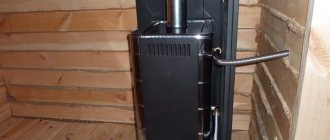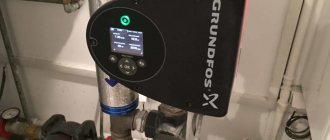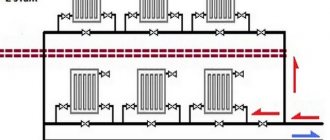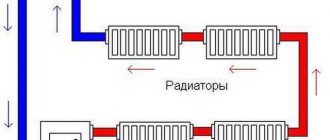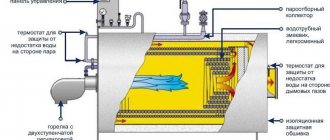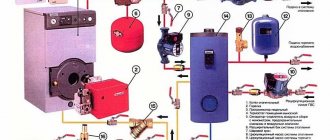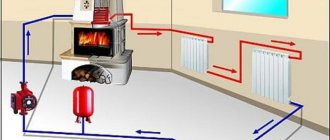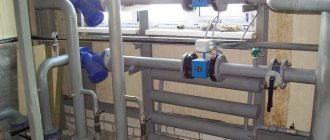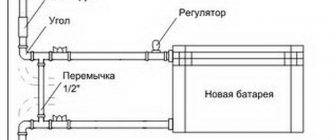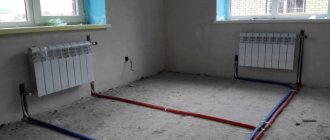Scheme of work
What is a single-pipe heating system for a private home? It can be compared to a closed ring into which a heating boiler is mounted - the main heating element. The boiler can operate on various types of fuel; its type and type depends on the preferences of the owner of the house. The ring itself is a pipe with a certain diameter and length. Radiators or registers are sequentially cut into the pipe.
The most important components of a perfectly functioning heating system are temperature, speed and coolant pressure. Achieving the right combination of these parameters during design and installation is the main task. And it is not as simple as it seems. Therefore, before you decide to install heating yourself, you need to weigh the pros and cons and, if in doubt, turn to professionals.
Gravity system
This home heating distribution is also called natural. This is because the coolant moves independently, without external physical forces . This movement is possible due to a decrease in the density of water when heated. Because of this, the liquid becomes lighter, and it is easily squeezed out of the heat exchanger by the heavier cold water that constantly flows into the boiler.
The heated coolant under the pressure created by the cooled water can not only float out of the boiler, but also rise up the riser to the roof of a two-story house.
The difficulty of using such a system lies in the fact that the water in the heat exchanger can be heated to different temperatures, that is, its density decreases in different ways, which is why the speed of its movement through the heating network varies. At the same time, the pressure that forces the hot coolant to move is not so great. Therefore, if you use such a wiring in a very large private house, then inside the last radiators the coolant will practically not move.
Another disadvantage is that the expansion tank is open . Therefore, air enters the coolant, which, when in contact with steel, causes corrosion. The consequence of this is premature failure of the boiler heat exchanger and steel radiators.
To improve the movement of hot water in this distribution, do the following:
- Large diameter pipes are used .
- Pipes are always placed at an angle of 3-5° .
- the accelerating manifold yourself . It is a tall pipe, the top of which is higher than all the registers. This end is located just below the open expansion tank.
- The expansion tank is placed above all other components of the system.
- The length of one circuit is made no more than 30 m.
Heating with horizontal installation for a one-story house
In a house with one floor, as a rule, a single-pipe horizontal heating system is installed. All heating devices on the floor are switched on in series.
System with horizontal liner.
If a pump is not used to move the coolant, then the horizontal pipe line must be laid with a slight slope in order to use the natural physical laws of the movement of liquids in the pipes. The downside here is that it is not always possible to achieve aesthetic beauty when installing pipes with a slope. But a system without a pump allows you to remain independent from electricity and not be afraid of cooling the house in its absence.
One type of horizontal heating installation is the specific “Leningradka” scheme. In it, pipes are laid above the floor surface or in the floor structure itself. Thermal insulation must be installed.
Installation recommendations
Pipe slope in a gravity heating system
Having completed the calculation for a gravity heating system made of polypropylene or steel pipes, you can begin installing it. To achieve optimal efficiency, experts recommend making small but important changes to the standard circuit:
- Highway slope . The optimal gravitational pressure for the heating system can be achieved by sloping the pipes after the air vent and on the return line behind the last heating device;
- Installing a circulation pump on the bypass . It will help reduce the inertia of the system. The heating time of the coolant can be very long, so the pump can increase the speed of its movement along the line until the desired temperature is reached;
- Minimum of turning units in the pipeline . They create excess hydraulic resistance, which reduces the speed of water movement;
- Installation of protective elements . By installing a check valve for gravity heating, you can prevent water from circulating in the wrong direction. This is especially necessary for a system with overhead wiring and multiple circuits.
The main components of a properly made pressure gravity heating system are a professionally made preliminary calculation, selection of the right materials and adherence to installation technology. This will make it possible to create an effective system for maintaining a comfortable temperature in the house.
Tips on arranging and using a gravity valve for heating when installing heated floors and additional elements can be seen in the video:
Heating with vertical installation for a multi-storey building
This scheme involves placing the pipes vertically, by installing risers that supply heat to the radiators. In this case, heating devices installed on different floors of the building are connected in series.
Vertical system.
It uses natural circulation of water in the absence of a circulation pump. Hot water is supplied through the riser from the boiler to the top point, passes into the supply line, heating devices, moves along the supply risers, giving off heat to the radiators.
Advantages and disadvantages of the collector system
Due to the emergence of a variety of plastic and polyethylene pipes, the collector heating system has replaced the tee system, due to the following advantages:
- When installing and operating a collector heating system, you can do without highly qualified specialists.
- The efficiency factor (efficiency) increases due to the fact that the coolant delivers heat to the radiators faster and with less losses . This is achieved due to the operation of the circulation pump and the poor thermal conductivity of plastic pipes. These pipes carry heat with the least loss to the radiators, which, thanks to their special design, effectively heat the room.
- Increasing the efficiency of the heating system makes it possible to reduce pipe diameters and boiler power, and also saves fuel.
- Since plastic pipes from heating devices to collectors do not have connectors (joints), they can be walled up in the floors and walls of the house . This gives an aesthetic appearance to the room.
- Makes it possible to heat a house without traditional radiators using heated floors.
- High maintainability. Since it is possible to disconnect any section of the pipeline from the water supply, without interfering with the functionality of the entire heating system.
- Simplicity of design , since there is no need to apply complex mathematical calculations.
- Possibility of adjusting the temperature on each heating device. What creates a certain comfort
The disadvantages of a collector heating system are:
- Airing the system . The air remains in the system after it is filled with coolant, which enters the heating devices horizontally and quickly under the influence of the pump. Air from microscopic bubbles combines and accumulates at the highest points of the radiators.
- High cost due to the presence of a pump, manifolds, shut-off valves and a large number of pipes for moving the coolant.
- Cannot work without circulation pump .
- A special room is required for the manifold cabinet.
- Labor-intensive installation and material consumption.
The nuances of the procedure for de-aerating heating radiators are described in this article:
From the above it is clear that the collector heating system is considered reliable and comfortable for a low-rise cottage. But the cost of this system is much higher than the tee system .
Advantages
A single-pipe heating system for a one-story house has a number of advantages over a two-pipe heating system. In particular, the single-pipe scheme makes it possible to cover the entire perimeter of the inside of the house with one closed ring, because only one pipe comes from the boiler. In addition to being economical, having one pipe has the following positive aspects:
- It is possible to design a heating system with one pipe regardless of the layout of the room and with minimal consumption of materials;
- Pipes are mounted in close proximity to the floor or hidden under the floor, which allows you to hide the entire engineering structure and design the interior without taking into account open communications;
- Any equipment at the owner’s request can be built into single-pipe heating - heated towel rails, radiators, pumps, accessories;
- The temperature of the coolant can be easily controlled, and, therefore, the procedure for creating maximum thermal comfort in the house becomes more flexible;
Features of one- and two-pipe schemes
A single-pipe scheme involves connecting radiators in series to one common pipe. This principle of organization leads to the fact that the coolant enters the first radiator, leaves it, enters another, also exits it, moves into the third, etc. This scheme is very simple and requires a minimum number of pipes. However, it has several disadvantages:
- Each subsequent radiator heats up less than the previous one , because colder water flows to it.
- In addition, in such a layout it is impossible to control the level of heat transfer of each individual battery .
A two-pipe system provides for the supply of water to the batteries through one pipe, and its removal through the other. Thanks to this, all registers warm up evenly. In addition, it becomes possible to control each radiator separately.
True, to create such a system in a private house, you need to purchase twice as many pipes. It is clear that the costs and labor intensity of all installation work are also increasing.
Difficulty in operation
During operation, it is rarely possible to achieve the coolant speed and pressure required for maximum heat transfer. To organize reliable and correct operation, an acceleration manifold is installed. A vertical heating system in a multi-storey building does not have such difficulties, and, accordingly, can function at full efficiency without installing a pump, allowing the necessary natural pressure to be created due to the height. Despite the fact that systems without a pump have a right to exist, it is still recommended to provide a pump in the chain of a single-pipe horizontal heating system.
Acceleration manifold.
The acceleration manifold performs its main task - it accelerates the heated coolant for distribution through pipes and radiators and continuously maintains such acceleration. The efficiency of operation depends on the height of the upper part of the collector; the height of the loop of the accelerating collector must be more than 2.2 m. At this height, sufficient speed of coolant movement and quiet operation are ensured.
System with double-circuit boiler
Its wiring is somewhat more complicated, because it also includes a second circuit. Its organization can be carried out according to any of the above schemes. In practice, the wiring method most often used for this circuit is the one that was chosen to create the heating circuit. As a result, it turns out that the difference between the heating distribution from a double-circuit boiler and the distribution from a single-circuit unit lies in the additional number of pipes.
Minuses
When choosing a single-pipe type of heating, you should keep in mind a number of its disadvantages, namely:
Serial connection of radiators
It does not make it possible to individually adjust the heating intensity of the radiator so that this does not affect other devices.
Thus, it is not possible to adjust the temperature in individual parts of the house depending on external weather conditions, as well as to establish the most comfortable conditions for each person living in the house.
High temperatures
Single-pipe heating requires higher temperatures during operation, which leads to increased boiling of the coolant and the need to control the water level and regularly top it up.
When using water as a coolant in a single-pipe system, be sure to install an expansion tank under the roof of the house.
Options for single-pipe heating systems
There are natural and forced types of circulation; the scheme can also be divided by type:
- Heat source. These can be solid fuel, gas, or electric boilers.
- For heat-emitting devices, such as radiators or a heated floor circuit.
- According to the transportation device. If the coolant flows by gravity, an accelerating section of movement is required; if forced circulation is installed, a pump is installed.
- Depending on the equipment for compensating excess pressure. Expansion tanks of open or closed type are used.
Also taken into account are the types of pipes based on the material of manufacture and the types of water fittings.
Schemes with natural and forced circulation
Natural circulation means that the coolant is transported through the pipe by gravity, forced circulation - using a pump. The first option requires the installation of pipelines with a certain slope to ensure water flow. An acceleration section is also needed to obtain the required pressure, which moves the liquid. The acceleration section is a vertical pipe extending from the boiler. The coolant rises through the pipe, then flows down through a pipeline connected to the pipe, filling the entire heating line and radiators.
If a single-pipe gravity heating scheme is carried out with an upper distribution for 2-storey buildings, the supply pipe serves as the acceleration section, only it rises to the required level. When installing a single-circuit system in a one-story building with horizontal wiring, you need an accelerating manifold with a height of at least 150 cm from the level of the first installed radiator.
Gravity flow schemes depend on the number of turns - the more there are, the more difficult it is to transport the carrier, so it is recommended to make no more than 2 turns along the entire highway. Also, the gravitational type of transportation creates problems with warming up the last heating device - cooling water does not warm up the battery well, so the number of sections has to be increased.
It will help to install a pump that can be placed at any turn in the highway. The operation of the pump eliminates all the disadvantages of a single-circuit circuit, accelerates the movement of the coolant, and guarantees the passage of liquid through any turns. Before installing the pump, you need to decide on the zone - despite the ability to install it at any point, the interaction of rubber parts with hot water is taken into account, which reduces the service life of the device. Therefore, it is recommended to install pumps on the carrier return flow pipeline, where low-temperature water circulates.
When choosing a scheme, you should take into account the advantages of forced ventilation:
- simplified implementation of complex heating schemes with turns, raising the coolant to the 2nd floor, attic;
- no need to buy pipes of different diameters;
- there is no need to calculate the angle of inclination of each section of the pipeline.
There are also disadvantages - dependence on power supply, the possibility of clogging of the device and the presence of maintenance costs (payment of electricity bills).
Open and closed systems
Schemes differ according to the type of expansion tank, which is mounted with the system. If it is a closed container, the system is closed; if there is no lid, it is open. The tank is installed at the highest point of the system. In sealed tanks there is an outlet for draining excess water or the internal space is divided by an expansion-type membrane - when there is excess liquid, the gas in one half is compressed, the membrane is extended, as soon as the volume of liquid is normalized, the membrane returns to its original position and provides the required pressure. The closed system is very easy to install and use.
An open tank is also placed at the highest point of the diagram, but the tank does not have a lid, so interaction with oxygen entering the pipes is possible - increasing the risk of airing. The advantage of using an open system is that there is no need to monitor the pressure and the possibility of making an expansion tank from scrap material. Users note a number of other disadvantages - water needs to be added to the tank, antifreeze cannot be used (the coolant will evaporate, and its vapors are poisonous), oxygen in the coolant wears out the pipes faster.
